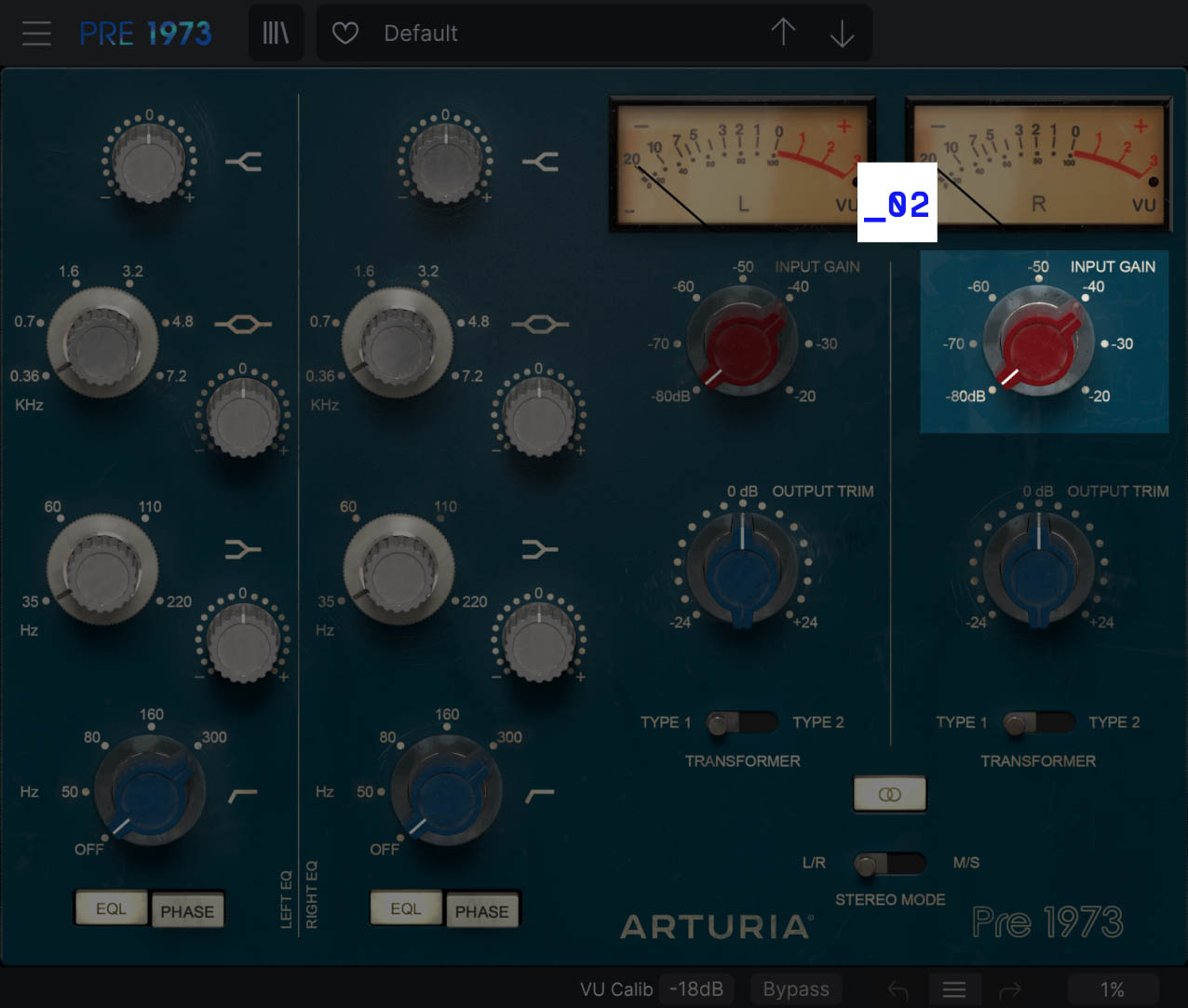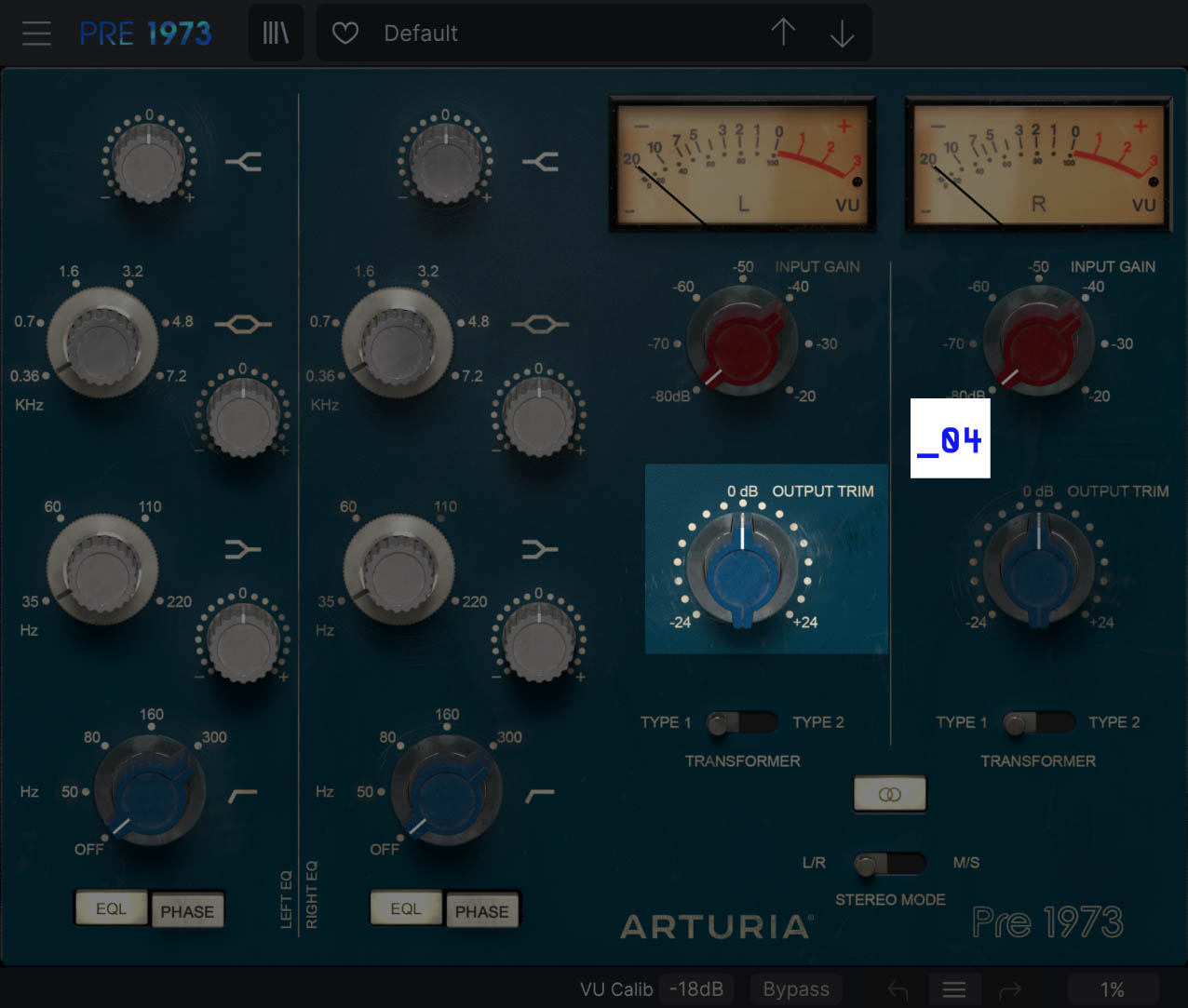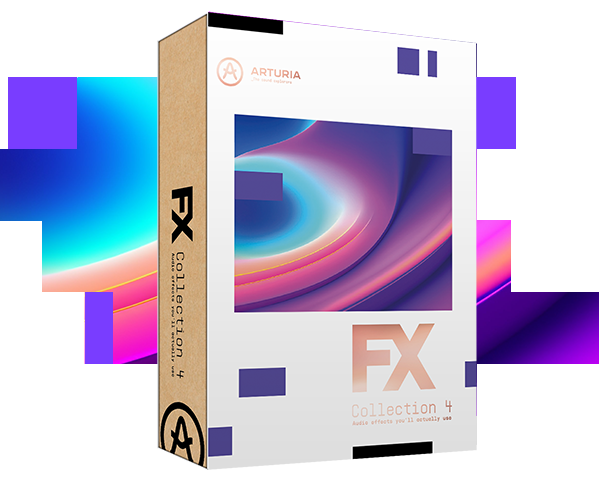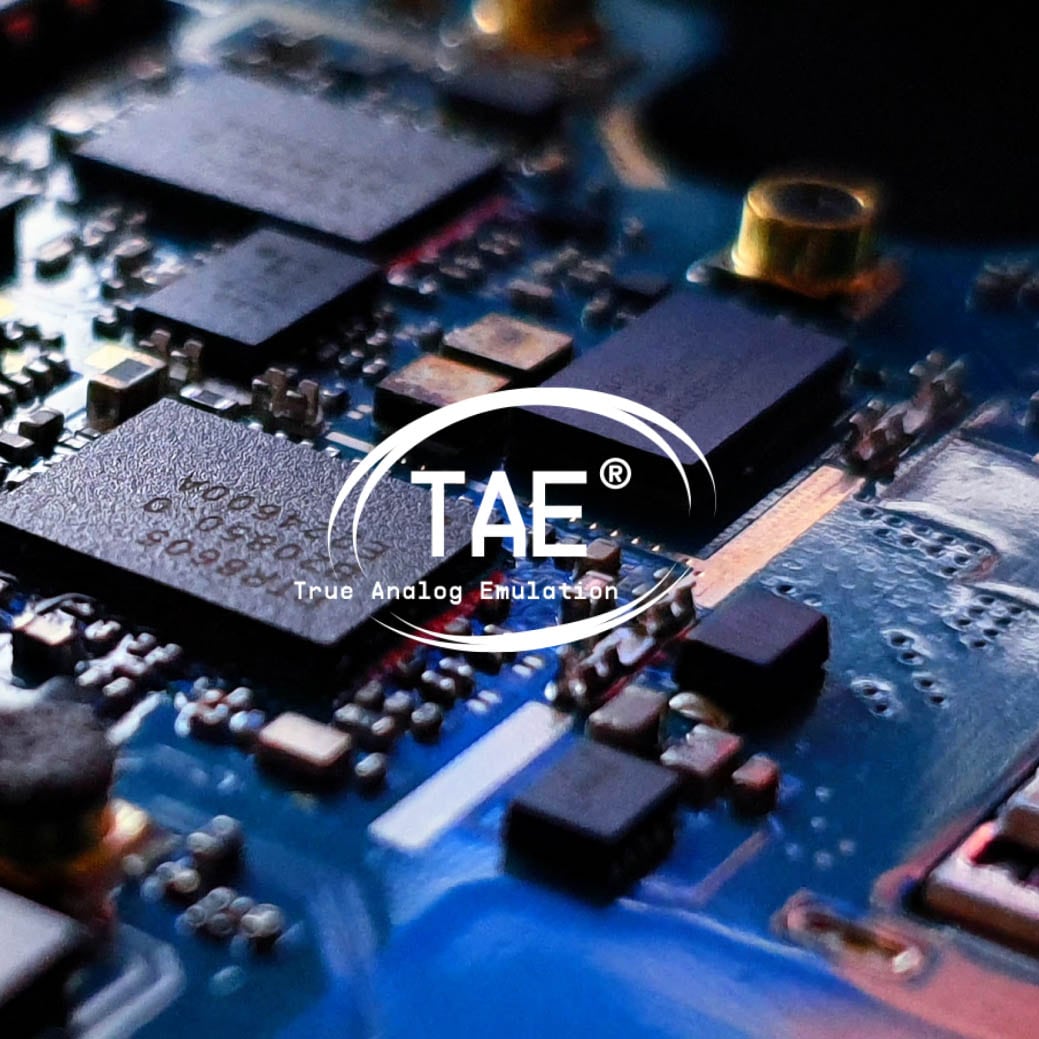As every modern music producer knows, the sheer amount of software plugins available seems almost limitless.
For years, top producers have coveted the sound of the venerable 1073 preamp. Now - through the power of Arturia’s advanced TAE modelling - you too can have a taste of that harmonically rich, classic tone in your DAW.
Devised by visionary electronics engineer and pro audio legend Rupert Neve, the preamp became a staple of the world’s top studios, and added its unique tonal flavor to countless hits. It was a revolution in 1970, pioneering the use of reliable high-efficiency transistors to replace the temperamental vacuum tube technology of the time.
The sound of the preamp became an instant hit with record producers, sound engineers, and artists the world over, cementing its place in music history.
Continuing that revolution, using their exclusive TAE technology, Arturia have recreated this phenomenal piece of music production history. Capturing and recreating its distinct musical color, its pleasing analog distortion, and its sweet-sounding tone controls, you’ll be able to start your virtual signal chain with one of the best sounding pres ever created.
Analog sound
in the digital world
“... but my audio interface already has preamps. Why do I need virtual preamps? What difference will it make? ”
Great question!
As you’ll know, preamps raise the gain of incoming signals - from microphones and musical instruments - to usable levels, which can then be mixed. Practically all modern audio interfaces include preamps, just as most analog mixing consoles integrated preamps in the pre-digital age.
Thanks to today’s technology, preamps are very neutral and transparent in the way they amplify the audio signal. In the past, preamps tended to subtly distort the sound, imparting a tonal character to the audio they processed; a sort of “sonic fingerprint” that music producers would become familiar with, and start to use in creative ways.
This is what people usually refer to when they talk about ‘the sound’ of a mixing console. Running a session on a mixing console that used the 1073 preamps, for example, would give the whole track a harmonically exciting feel.
Now, you can enjoy the best of both worlds. You can use the preamps on your audio interface to get your signals to a usable level, and use Arturia’s software preamps to impart that iconic tone to your tracks.
Adding that
“je ne sais quoi”
It’s difficult to let new producers and mix engineers know just how important the subtle sound-shaping power of preamps are;
We’re talking about something understated. It’s not a flashy synth or an extreme audio-mangling plug-in.
At their core, all of our preamp plugins provide 2 main benefits.
That’s what we think, anyway. How you decide to use Pre 1973 is up to you. Maybe you’ll just love the way drums sound when you slam the input gain and pull down the high end. In fairness, that does sound pretty awesome.
A link to the past
The original EMT®️ 140 was breakthrough technology: the world’s first plate reverb. Brighter and more versatile than the spring reverbs and echo chambers that preceded it, this plate reverb unit became part of practically every top studio’s arsenal. It was a serious investment, costing as much as a house, and weighing more than 3 people. Now, thanks to our exclusive physical modeling technology, you can use this studio legend in your DAW, without breaking the bank, or breaking your back!
Mixing confidence
Our reimagined version lets you adjust the pre-delay to let your original sound have space, a high-pass filter on the input to hone its tone, integrated chorus, and even a post reverb EQ to make sure the effect perfectly complements your track. Rev PLATE-140 lets you filter and EQ your sound before it even hits the plate, so you can get rid of all those muddy or bright frequencies you don’t want to enjoy a lush, vintage reverb whenever you like.
Cracking
the code
We built our award-winning reputation on accurately modelling classic synthesizers and keyboards, now we extend our expertise to bringing legendary, rare, and unattainable pro audio hardware to every modern music creator.
We didn’t just want to make something that sounded like a 1073, we wanted to create a living, breathing emulation to bring you as close as possible to the joyous original, and go beyond your expectations. To do Rupert Neve’s brainchild justice, we analysed the unique response of every electronic component of the hardware. To guarantee the best preamp sound, Arturia’s engineers travelled the world, visited studios, and spoke to producers and engineers who use their 1073 on every project.
When designing the Pre 1973, our quest brought us to London, England. There, we were able to spend some time with unit #3392, an original unmodified 1073 built in 1971.
This particular preamp helped shape the course of popular music for almost half a century. Now owned by Fish Factory Studio, it also played its part in creating iconic Blur and Gorillaz tracks when it was used by Damon Albarn’s sound engineer.
Taking its rightful place alongside the best performance keyboards, analog synths, and digital powerhouses in Arturia’s virtual hall of fame, the Pre 1973 is ready to show you what it’s made of.
The ultimate
sound-shaper
Beautifully simple, yet stunningly effective, the Pre 1973 offers simple controls that pros will feel right at home with, and newcomers will quickly learn to love.

Creatively shape your signal with low, medium, and high band controls of +/- 18dB. The low band lets you perfectly balance the bass content in your signal, the mid band can add presence or cut the mud, and the high band can add shine and air, or remove any unwanted sharpness.

Controls how much of your signal is sent through the circuitry. Subtle levels will introduce that flattering brilliance that the 1073 is known for. Pushing harder will introduce harmonic distortion, adding presence and fatness.

Rather than the now standard “threshold” parameter, the original hardware compressor made you crank the input to engage the effect. This will obviously give you volume boosts and alter levels in your mix, but you can simply hit the “link” button to keep volume levelled as you boost the input, so you get compressed sound with steady volume.

“Shame compressors from the ‘50s weren’t set up for side-chaining” you cry, but don’t worry, we’ve got you covered. The advanced panel gives you access to contemporary sidechain controls with SSL-style EQ, as well as mid-side processing so you can carve exactly the sound you want to control the compressor.
It’s fair to say that in the 50 years since unit #3392 was built, the music industry has seen some changes. To bring this legend up to date, we’ve also included some optional enhancements to make the most of your DAW.
To top it all off, we even recreated the vintage style of the interface in a glorious, high-definition GUI. Every aspect of the Pre 1973 has been meticulously put together, ready to take your music to the next level.
- Automatic gain control intelligently alters the output volume based on the changes you make to the input gain.
- Continuous controls, rather than stepped, for extra creative precision.
- Switchable transformers, letting you choose between the original Carnill and the modified Marinair components, so you can easily choose which hardware voicing sounds best on your signal.
- Self contained mid/side mode, so you don’t need to use additional convertors to use this advanced studio technique, your audio will sound amazing in both mono and stereo.
New
Features
Talking about sound is like dancing about architecture. We’ll let your ears be the judge.
Without going into too much detail on how the Pre 1973 shapes your sound, you’ll find that its unique tonal flavor, its powerful equalizer, and its pleasing harmonically rich distortion will give you a solid, time-tested foundation on which to build your tracks.
When each channel of audio is given the Pre 1973 top-studio shine, mixing becomes a breeze, and your music will take on a vital, iconic character. Don’t take our word for it, listen for yourself.
Want to try it on your own audio? Remember that you can download a free trial of the plugin so you can experience it in your own setup.
The Pre 1973 characteristic tone, combined with the power of M/S processing, add strong character to this live drum track.
The Pre 1973 presence mid bell EQ adds fine tone edge for a crunchier feel in this vocal example with less mud.
The thick and compact low shelf filter preset of the Pre 1973 improves this not-so-well recorded kick drum, adding strong body and low end.
This setting warms up this bass guitar example with an amplifier style buzz and resulting harmonics.
The Pre 1973 analog clipping is clearly heard, favoring the high mids crunch of this hip hop loop.
Artistscorner
Included in
FX collection
Effects you'll actually use
This effect is part of FX Collection, a suite of essential audio effect plugins empowering musicians, producers, and artists to get creative with their production. From iconic recording gear modeled with breathtaking accuracy, to cutting-edge contemporary effects, the collection includes the most sought-after studio tools, rare guitar pedals, modern mix enhancers, and beyond. Elevate your production and add color to your mix like never before.
Learn More
The features
you need

However you use these plugins; for the amazing tone of their reverb, for the gritty preamps, or for their incredible sound design abilities, you'll be safe in the knowledge that they are fully compatible with your setup. These plugins work with all major DAWs, and on both Windows and MacOS.

Arturia Software Center lets you download, organize, and update all of your Arturia software titles in one place, as well as manage all of your licenses across multiple devices. Keep it simple.

Whether you want the full visual immersion of our classic effects emulations, or to save precious screen real estate, the interfaces for all of your Arturia plugins can be resized to a scale that suits you.

Every parameter in every FX Collection plugin can be mapped to your favorite MIDI controller for instant, hands-on control of your mix. Sweep a filter, crank a preamp, or warp your modulation on the fly.

Every plugin in FX Collection comes with built-in tutorials, guiding you step-by-step through the crucial parameters, adjustments, and mixing hacks to get the most out of your sound. The tutorial panel also explains the controls you’re using in real-time - so you’ll never miss a tweak.

FX Collection’s streamlined preset browser lets you filter, organize, and save your favorite presets for instant recall. Search by instrument type, genre, production technique, and much more - so you can quickly find the tweak you need and save valuable creative time!
TAE® Powered
The exclusive analog modeling technology that makes our emulations indistinguishable from the originals.
By accurately mimicking the characteristics of analog oscillators, filters, and soft clipping, we can provide astonishing component-accurate detail and authentic analog charm in equal measure.
Learn more
Gallery
Main Features
Virtual recreation of famed classic British preamp
- 60 dB virtual continuous input gain
- 2 type of output transformers
- +/- 24 dB Output trim level
Complete switchable EQ section
- Include bypass & phase Inversion switch
High Shelf Filter
- +/- 18dB gain
- Fixed frequency of 12kHz
Midrange Bell Filter
- +/- 18 dB gain
- Continuous frequency range from 360Hz to 7.2kHz
Low Shelf Filter
- +/- 18dB gain
- Continuous frequency range from 35Hz to 220Hz
High Pass Filter
- -18dB/oct. Slope
- Continuous frequency range from 50Hz to 300Hz
1 & 2 channels plugin versions
3 stereo modes
- Stereo Link
- Dual Mono Channels
- Mid/side (M/S) encoding-decoding for advanced stereo processing
Output Analog VU meter
- 3 calibrations mode (-18dBFs, -12dBS, -8 dBFs)
- Analog clipping LED indicator
Comprehensive set of presets
State-of-the-art TAE® analog modeling
Platforms specifications
Windows
- Win 10+ (64bit)
- 4 GB RAM
- 4 cores CPU, 3.4 GHz (4.0 GHz Turbo-boost)
- 1GB free hard disk space
- OpenGL 2.0 compatible GPU
- ARM processors not supported on Windows
Required configuration
- VST, AAX, Audio Unit, NKS (64-bit DAWs only).





Apple
- Mac OS 11+
- 4 GB RAM
- 4 cores CPU, 3.4 GHz (4.0 GHz Turbo-boost) or M1 CPU
- 1GB free hard disk space
- OpenGL 2.0 compatible GPU
Work with ASC
- An elegant and simple solution to help you install, activate, and update your Arturia software.
* All manufacturer and product names mentioned on this page are trademarks of their respective owners, which are in no way associated or affiliated with Arturia. The trademarks of other manufacturers are used solely to identify the products of those manufacturers whose features and sound were studied during the development. All names of equipment, inventors, and manufacturers have been included for illustrative and educational purposes only, and do not suggest any affiliation or endorsement by any equipment inventor or manufacturer.
*NKS ready
